Five recipes that will change the way you think about salt
It’s the most common ingredient and yet you probably never think of it. You should, says Hannah Twiggs

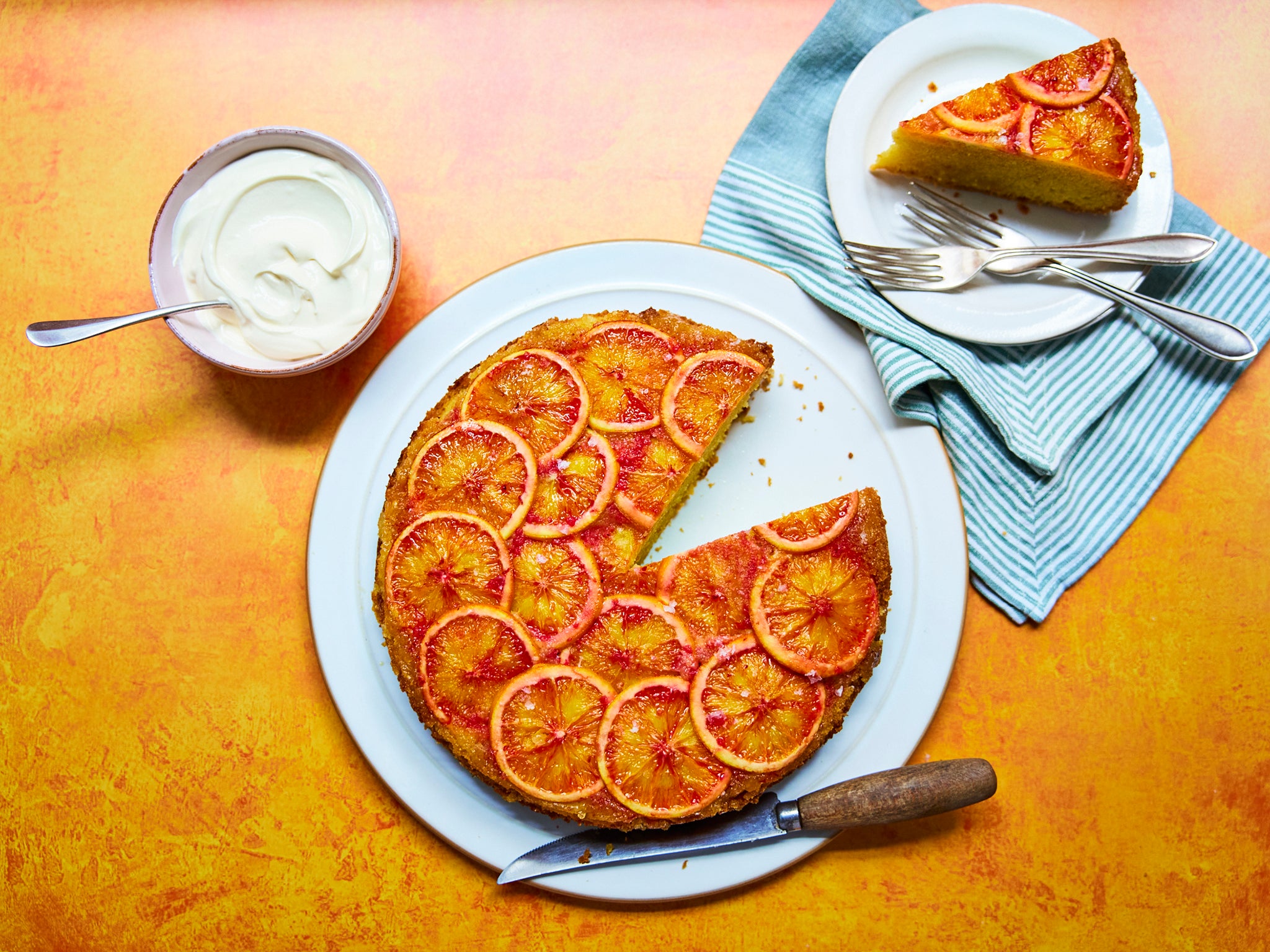
Your support helps us to tell the story
From reproductive rights to climate change to Big Tech, The Independent is on the ground when the story is developing. Whether it's investigating the financials of Elon Musk's pro-Trump PAC or producing our latest documentary, 'The A Word', which shines a light on the American women fighting for reproductive rights, we know how important it is to parse out the facts from the messaging.
At such a critical moment in US history, we need reporters on the ground. Your donation allows us to keep sending journalists to speak to both sides of the story.
The Independent is trusted by Americans across the entire political spectrum. And unlike many other quality news outlets, we choose not to lock Americans out of our reporting and analysis with paywalls. We believe quality journalism should be available to everyone, paid for by those who can afford it.
Your support makes all the difference.Everyone has it in their kitchen, and it’s used in almost every meal. Yet for something so ubiquitous, it can drastically make or break a dish, from breakfast through to dessert.
Yes, I’m talking about salt. It’s important! And you’re probably not making the most of it. Here’s five inspiring recipes to change that.
Blood orange olive oil cake
The combination of blood oranges and olive oil makes a wonderfully flavoursome cake that is not too sweet. It is topped with blood orange slices for a real showstopper dessert.
Ingredients:
5 blood oranges
250g golden caster sugar
150g plain flour
80g semolina
2 tsp baking powder
Pinch of Maldon Salt
1 orange, zested and juiced
1 tsp vanilla extract
3 large eggs
250ml extra virgin olive oil, plus extra for greasing
Creme fraiche, to serve
Method:
1. Grease a 20cm round cake tin with olive oil and line the base with parchment paper. Preheat the oven to 190C.
2. Take the blood oranges and carefully cut into thin rounds (as thin as you can go!). Start by sprinkling 30g of the golden caster sugar on the bottom of the cake tin, over the paper. Then arrange the slices on top in a nice circular pattern. Use the end pieces of the blood oranges to squeeze over any remaining juice and then set aside while you make the cake batter.
3. In a large mixing bowl mix together the plain flour, semolina, baking powder and Maldon salt. Adding salt to your baking helps balance and enhance flavours, balancing sweetness and acidity.
4. Next, in a smaller bowl mix together the orange juice and zest, vanilla extract and olive oil.
5. Place the eggs and sugar into a stand mixer – or you can use an electric whisk – and beat them together until they are pale and fluffy. Add the dry ingredients, followed by the wet ingredients and beat until smooth.
6. Pour the cake batter into the tin on top of the orange slices and smooth over the top. Place the cake tin into the preheated oven and bake for 30-40 minutes until golden brown on top and cooked through.
7. Remove from the oven and allow to cool for 10 minutes. Then carefully remove from the cake tin before turning it upside down onto a plate and peeling off the baking paper. Allow the cake to then cool completely before slicing and serving with crème fraiche.
Butternut squash spaghetti with fried courgette, mint, burrata and lemon zest
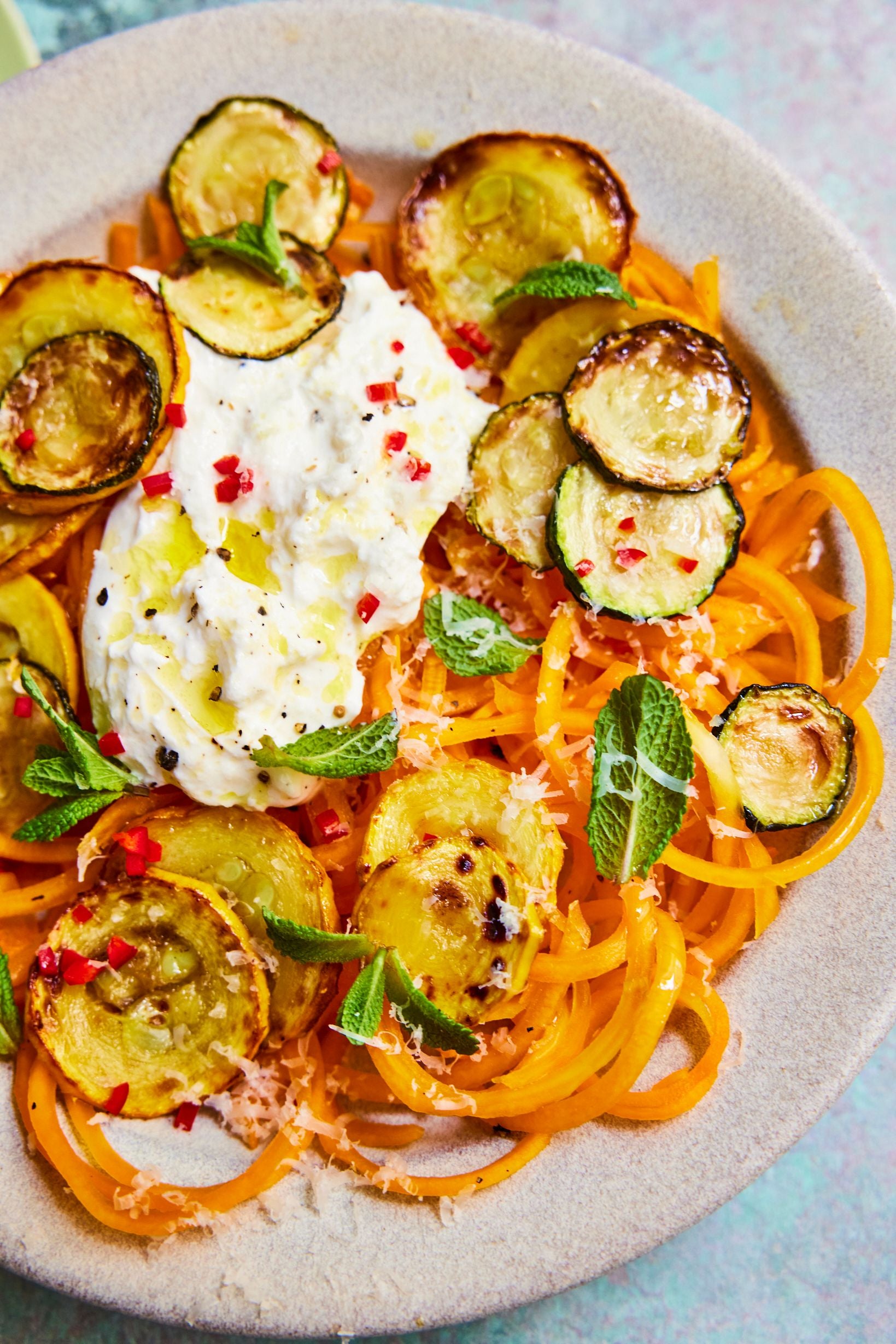
This recipe shows you how easy it is to make butternut squash spaghetti by spiralising the squash, which makes a great and healthy alternative to pasta. You can make different sauces for your squash spaghetti; however, this is a lighter alternative which uses burrata, courgette, mint and lemon.
Ingredients:
½ butternut squash, spiralised
1 green courgette, thinly sliced
1 yellow courgette, thinly sliced
15g fresh mint, leaves picked
Half red chilli, deseeded and finely diced
2 tbsp olive oil
100g burrata
Maldon salt
Cracked black pepper
Method:
1. Begin by peeling and deseeding the butternut squash. Then cut into sections and using a spiraliser, creating long ribbons which look like spaghetti. Place a large frying pan on the heat and drizzle with 1 tablespoon olive oil. When the pan is hot, add the butternut squash spaghetti and sauté for 5-7 minutes until softened and golden. Remove from the heat.
2. While the butternut squash is cooking, place a second small frying pan onto the heat and drizzle in 1 tablespoon olive oil. When the oil is hot, add the slices of courgette and fry for a few minutes on each side so they are golden and toasty – you made need to do this in batches. Remove them from the heat.
3. Now you can plate up – pile a golden heap of butternut squash spaghetti onto two plates. Top with some burrata, fried courgette slices, diced chilli, fresh mint leaves and some lemon zest. Finish each plate with a final pinch of Maldon salt, some cracked black pepper and a drizzle of olive oil.
Green vegetable baked eggs with spinach and feta
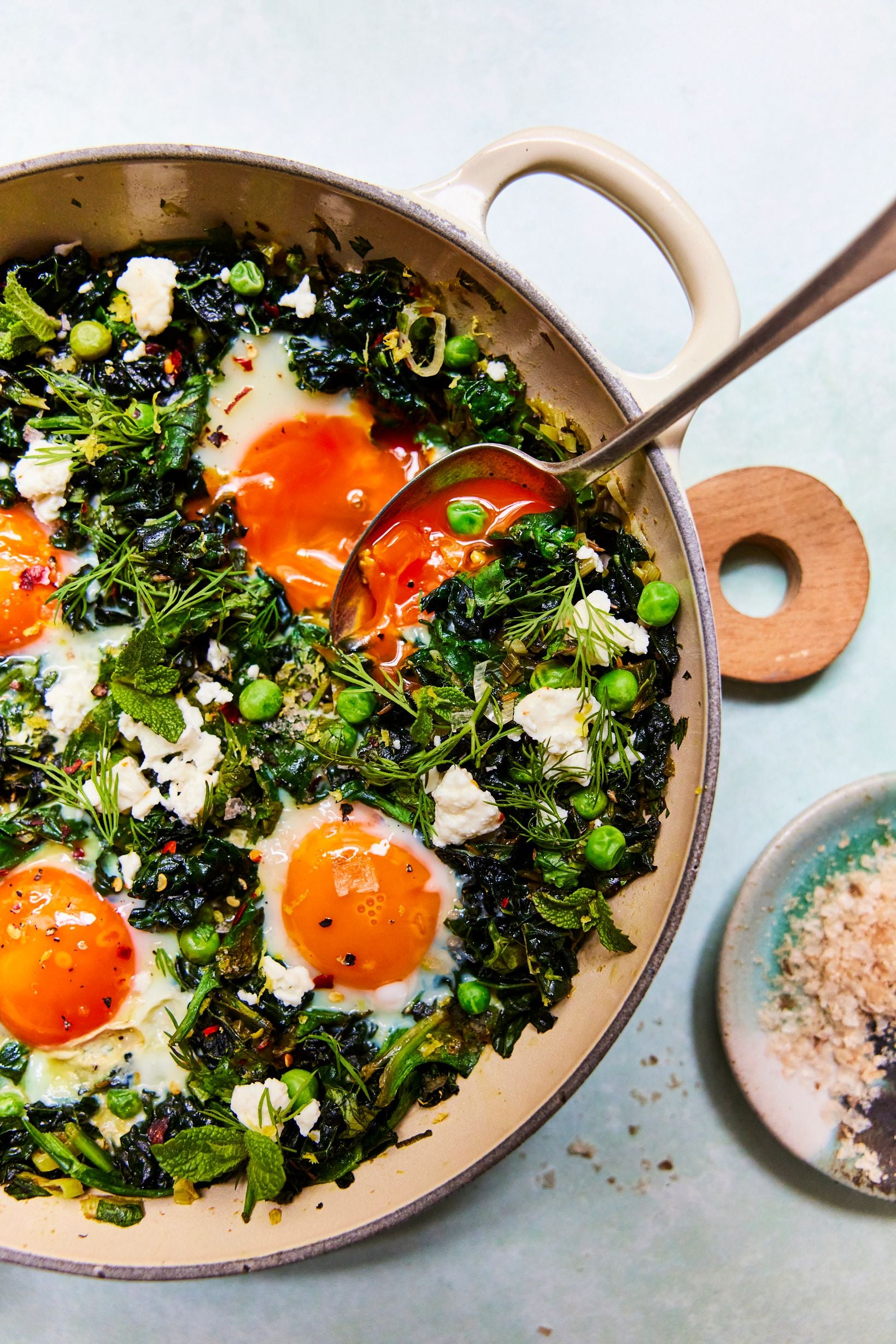
This recipe is packed full of hearty green vegetables and baked eggs. It is full of flavour from the spices, feta, herbs and lemon and makes a great brunch or lunch dish.
Ingredients:
2 tbsp olive oil
3 spring onions
1 garlic clove, crushed
1 tsp cumin seeds
1 tsp ground coriander
100g cavolo nero, shredded
100g baby spinach
½ lemon, zested and juiced
40g frozen peas
4 eggs
25g fresh coriander, roughly chopped
15g dill, fronds picked (plus extra for garnish)
A small handful fresh mint, leaves picked
20g feta cheese
Pinch of chilli flakes
Maldon salt
Method:
1. Take a large frying pan – a cast iron pan works well for this, as it needs to be oven proof also – and place on a medium heat. Heat 1 tablespoon of olive oil, and when hot, add the sliced spring onions and fry gently until softened.
2. Once softened add the crushed garlic, cumin seeds and ground coriander and continue to fry for another 2 minutes until starting to smell fragrant.
3. Next add the cavolo nero, spinach and lemon juice and zest. Cook this down gently, stirring often for 5 minutes until the cavolo nero and spinach has softened and wilted. Once they are cooked down, add the frozen peas, chopped coriander and dill fronds and cook for another 2 minutes.
4. Now you want to create 4 shallow wells in the vegetable mixture and carefully crack the eggs into each hole. Turn the heat down and gently cook the whites to be just set but the yolks to still be runny, so it is worth keeping an eye on them.
5. Remove the pan from the oven as soon as the eggs are cooked. Top the dish with the feta cheese crumbled over the top, the picked mint leaves and some extra dill fronds. Finally finish with a drizzle of olive oil, some Maldon salt and cracked black pepper. Serve the eggs immediately to the table for everyone to serve themselves alongside some toasted sourdough.
Radicchio salad with sliced apple, rocket, pecorino and pine nuts
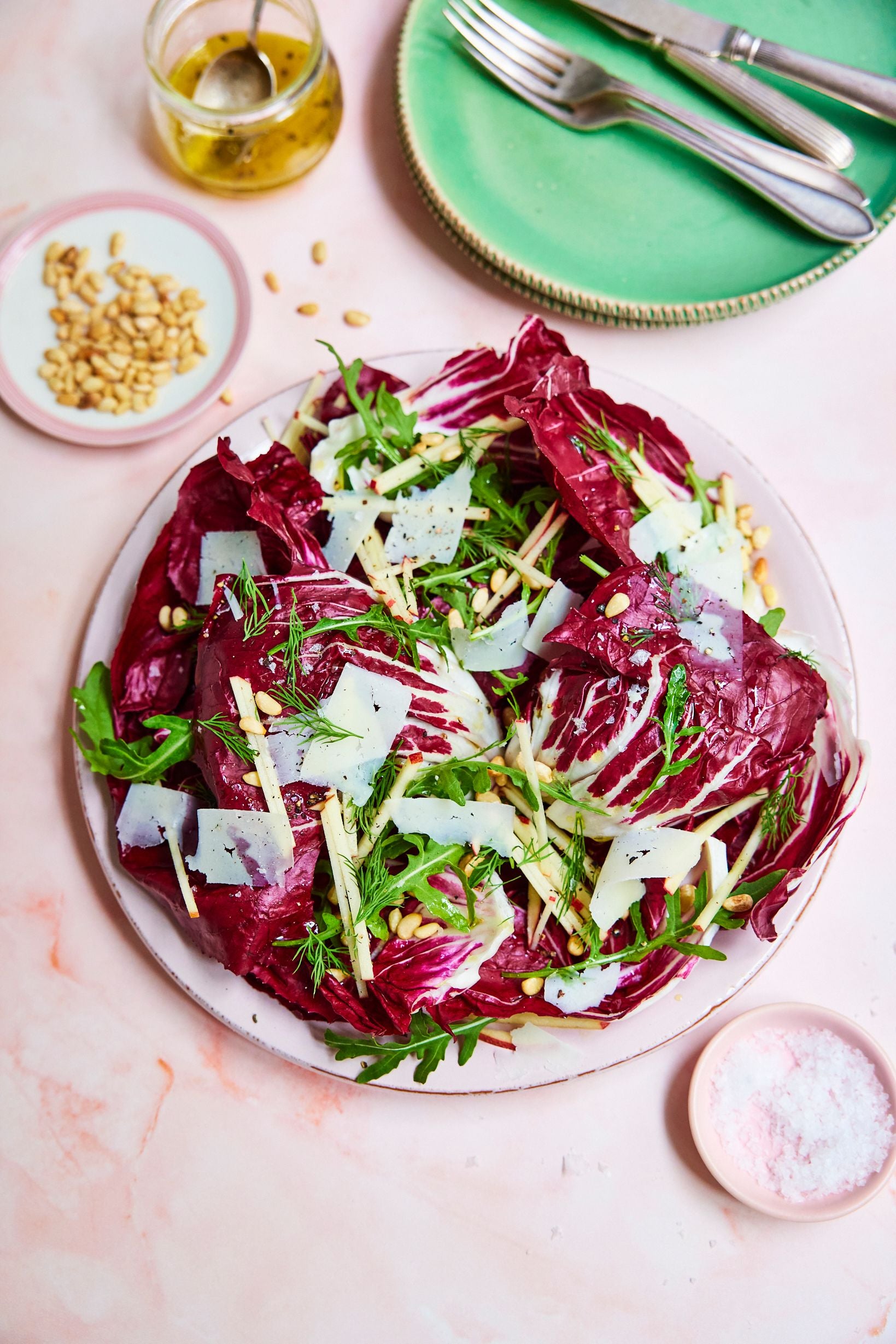
This recipe shows you how to prepare radicchio for salad and combines apple, rocket, pecorino and pine nuts along with a beautiful dressing.
Ingredients:
1 red radicchio
1 eating apple, sliced into matchsticks
50g wild rocket
25g pecorino, shaved
20g pine nuts, toasted
10g dill
For the dressing:
½ lemon, juiced
1 tbsp olive oil
1 tbsp Walnut oil
1 tbsp cider vinegar
Maldon Salt
Cracked black pepper
Method:
1. Start by preparing the dressing for the salad. In small bowl or jug, combine the lemon juice, olive oil, walnut oil and cider vinegar. Whisk together and then season with Maldon Salt and cracked black pepper. Set aside.
2. To prepare the radicchio, carefully pluck the leaves off working your way into the centre core. Once you reach the inside white core, discard this as it can be bitter and tough.
3. Arrange the radicchio leaves on a large serving platter and toss with the apple matchsticks, wild rocket and dill.
4. Drizzle the dressing over the leaves and apple before topping with the pecorino shavings and toasted pine nuts, plus a final garnish of dill fronds.
Roasted parsnips with giant couscous salad, roasted red onions, feta and parsley
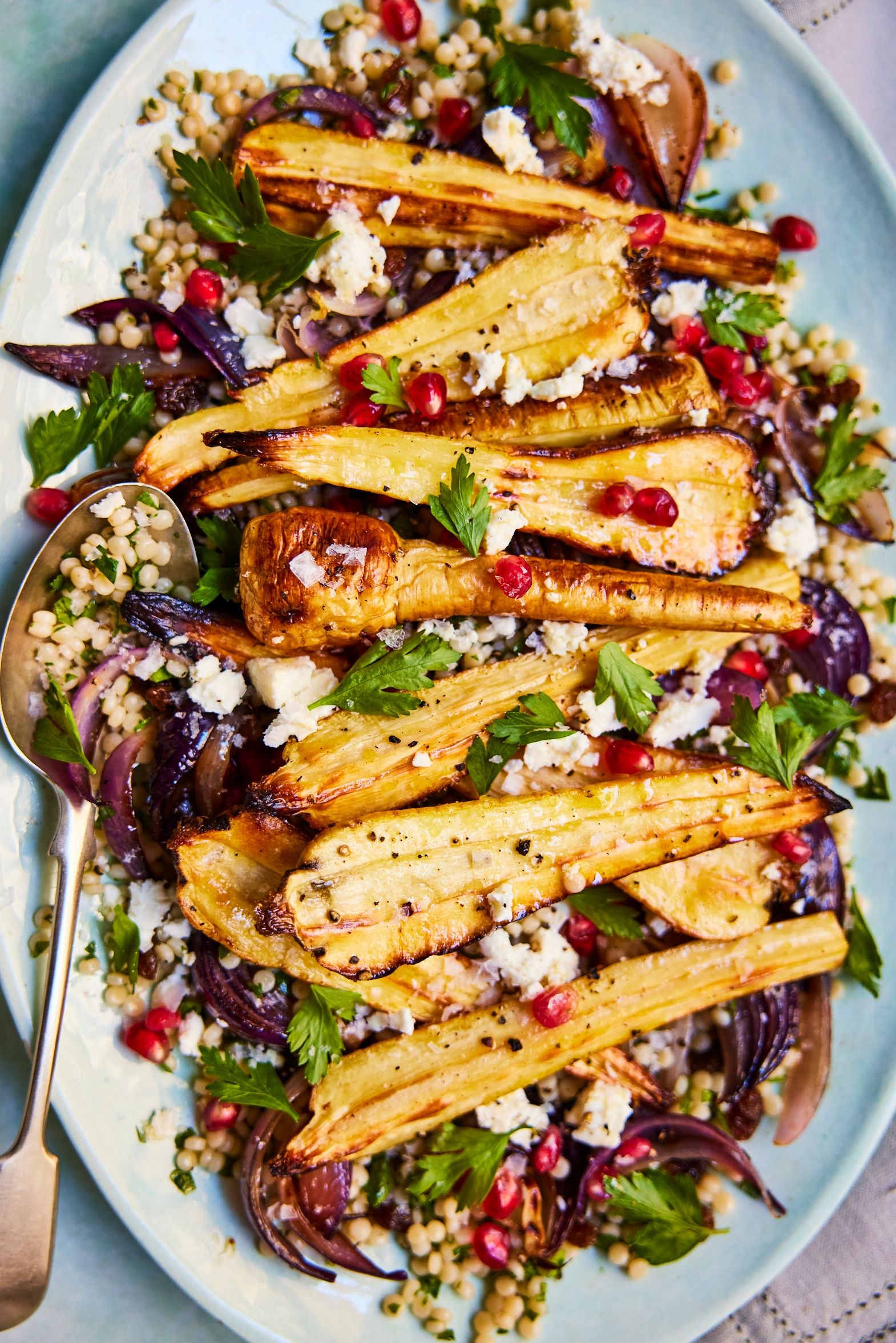
Parsnips are a very healthy ingredient, providing plenty of vitamins, minerals and fibre. They are also low in fat and are packed full of flavour. As a root vegetable they serve themselves well when roasted and this delicious salad is a great way of adding them into your diet.
Ingredients:
200g giant couscous
4 tbsp olive oil
6 parsnips
3 red onions, thinly sliced
25g golden sultanas
25g parsley, finely chopped
50g feta, crumbled
20g pomegranate seeds, to garnish
Pomegranate molasses, to garnish
Maldon Salt
Cracked black pepper
Method:
1. Begin my preheating the oven to 180C. Prepare the parsnips by simply cutting the larger ones in half lengthways but keeping any small one’s whole. Place them into a roasting tray and drizzle with 2 tablespoons olive oil, some Maldon Salt and cracked black pepper. Toss them so they are well coated and then place in the preheated oven for 30 minutes, turning halfway through. They should be golden brown and crispy on the edges.
2. While the parsnips are cooking, prepare the couscous. In a saucepan, cook the couscous according to the packet instructions. Once cooked, drain and remove from the heat. Add the remaining 2 tablespoons olive oil, plenty of Maldon Salt and cracked black pepper. Allow the couscous to cool.
3. Once the couscous has cooled and the parsnips are out of the oven (and also cooled). Stir the finely sliced red onion, chopped parsley, sultanas and crumbled feta into the couscous. Check the season and adjust if needed.
4. Pile the couscous onto a serving platter and top with the roasted parsnips. Garnish with the pomegranate seeds, a little extra parsley and a drizzle of pomegranate molasses.
For more salt recipes, articles and culinary tips, visit the Maldon Salt website, here.
Join our commenting forum
Join thought-provoking conversations, follow other Independent readers and see their replies
Comments